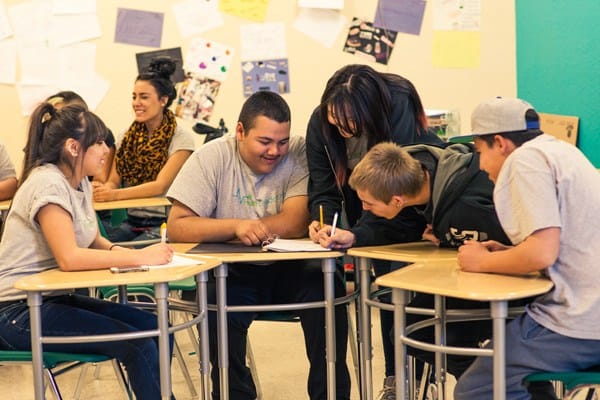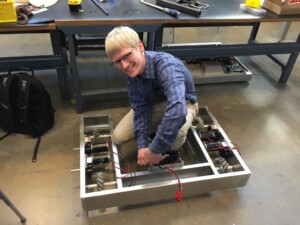Community Defined Projects at Health Leadership High

Imagine a health high school that is not just a talent pipeline but an advocacy organization for a healthier community. Imagine a health high school that asks providers for input on projects of current community significance.
Health Leadership High School in Albuquerque is a small project-based high school for students not well served by traditional schools. The hands on, community connected, project based school prepares young people to become successful leaders in the healthcare industry.
“We don’t have classes,” said Executive Director Blanca López. “ We have projects. Most students work on three per day. It’s the main focus of the school.”
Each summer the staff solicits project ideas from community health providers. Community Engagement Director, Moneka Stevens, leads the effort to engage all the health care providers in the city to propose projects.
Every project must have deliverables valuable to the community. “We see where needs are. We create advocates for change,” added López.
Health Leadership serves about 180 youth from 14 to 24 years old. “We want kids to see themselves as leaders in the community,” said López.
Director of Curriculum & Instruction Amber Reno (below) explains the link between community connected projects and student supports. “We ask more than regular schools,” said Amber. As a result, they see tremendous growth between each of the three student presentations annually.

Health Leadership students participate in a paid internship. It gives the school the opportunity to backward map projects from work experiences which makes them even more authentic. Students are prepared to add value right away when they enter their internship
“Being paid helps students avoid the unfortunate tradeoff of working a dead end job now to support your family versus an unpaid internship that can position you for a career,” said Moneka.
Health Leadership students take their role of community health advocates seriously. After the Parkland shooting, students planned a demonstration to advocate for gun safety. Students have taught sexual health in local middle schools. They organized a disabilities rights project. Amber said the compassion it developed for other students was powerful.
The Practicum is a year long senior project. Last year a student developed LGBTQ group presented to the other schools in the network.
Students meet with their advisor for an hour each day. They check in on projects and build social and emotional skills using asset-based resources from the Search Institute. The goal of the advisory system is to help young people leave ready for community, work, and life.
In two years the school will relocate to a new building across from a partner clinic, South Valley Family Health Commons. With another clinic partner, Casa de Salud, students get valuable work experience.

The school has a simulation lab where students practice nursing skills and earn college credit.
The Leadership Schools Network
Health Leadership is part of a network of industry-focused schools in Albuquerque. Many of the students they serve were either off-track to graduation or had dropped out.
The Leadership Schools Network serves marginalized students by developing innovative, student centered, community responsive schools aligned to dynamic industries in New Mexico.

New Mexico doesn’t have charter management organizations. Leadership Schools are developed and supported through an informal relationship with Future Focused Education (formerly The New Mexico Center for School Leadership), a nonprofit led by Tony Monfiletto.
The three design pillars of Leadership Schools are
- Learn by doing: problem-solving and innovation to address real-world problems, performance assessment of learning outcomes;
- 360 support: high expectations require high levels of student support focused on positive youth development and successful transition to adulthood; and
- Community engagement: initiating, building, and maintaining community partnerships with a focus on creating solutions together.
The other schools in the network include ACE Leadership High School (featured here) Technology Leadership High School, and Siembra Leadership High School.
Future Focused Education supports the continuous improvement of and knowledge transfer between the Leadership Schools.
Leadership Schools use the Imblaze mobile application from Big Picture Learning to manage student internships. They manage and document the process, Tony said, “because we want employers to recognize these credentials.”
Leading New Mexico to Opportunity
Tony Monfiletto grew up in Albuquerque. After graduating from New Mexico State, he worked in Chicago before returning to New Mexico to work on the state budget. In 1999, Tony founded Amy Biehl High School.
In addition to launching the Leadership Schools Network, Tony has been actively involved in creating a policy climate that welcomes innovative solutions for youth populations least well served.
Tony’s nonprofit, Future Focused Education, is housed in a co-working space in the old library of the recently redeveloped Albuquerque High School (below). He’s beginning to work with other cities on innovative solutions for disengaged youth.

Tony is passionate about serving disconnected youth, the kids that others gave up on. He has come to appreciate the importance of school networks. He has developed a half a dozen schools but recognizes that they plateau with no outside influence. “We grow by belonging to a network, it’s how we get better,” added Monfiletto
“I’m a finance guy, but I’ve had to rethink return on investment,” said Tony. For the last 20 years, he’s seen policy leaders take a narrow frame of reference and focus on a narrow set of goals. His mindset shift came from “spending time with people that think differently about the world.” He now appreciates broader outcomes that may occur over a longer timeframe.
While the network helps, it hasn’t solved the preparation challenge. Director López said, “Teacher preparation does not prepare teachers for this approach; it’s a different role–one of a project manager and facilitator.
The network supported the development of paid internships. “It’s a big part of our belief that our young people can make Albuquerque a healthier and more prosperous city and we need them in the game getting real experience to do it,” said Monfiletto.
For more see:
- How a Pittsburgh Network is Remaking Learning
- Integrated Learning Propels Pittsburgh Students
- 100 Middle and High Schools Worth Visiting
Stay in-the-know with all things EdTech and innovations in learning by signing up to receive the weekly Smart Update.





0 Comments
Leave a Comment
Your email address will not be published. All fields are required.